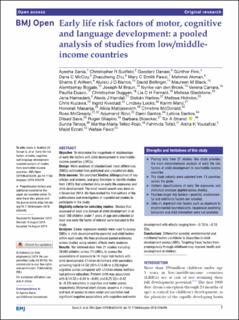| dc.contributor.author | Sania, Ayesha | |
| dc.contributor.author | Sudfeld, Christopher R. | |
| dc.contributor.author | Danaei, Goodarz | |
| dc.contributor.author | Fink, Günther | |
| dc.contributor.author | McCoy, Dana C. | |
| dc.contributor.author | Zhu, Zhaozhong | |
| dc.contributor.author | Fawzi, Mary C. Smith | |
| dc.contributor.author | Akman, Mehmet | |
| dc.contributor.author | Arifeen, Shams E. | |
| dc.contributor.author | Barros, Aluisio J. D. | |
| dc.contributor.author | Bellinger, David C. | |
| dc.contributor.author | Black, Maureen M. | |
| dc.contributor.author | Bogale, Alemtsehay | |
| dc.contributor.author | Braun, Joseph M. | |
| dc.contributor.author | Van den Broek, Nynke | |
| dc.contributor.author | Carrara, Verena | |
| dc.contributor.author | Duazo, Paulita | |
| dc.contributor.author | Duggan, Christopher P. | |
| dc.contributor.author | Fernald, Lia C. H. | |
| dc.contributor.author | Gladstone, Melissa | |
| dc.contributor.author | Hamadani, Jena Derakhshani | |
| dc.contributor.author | Handal, Alexis J. | |
| dc.contributor.author | Harlow, Siobán | |
| dc.contributor.author | Hidrobo, Melissa | |
| dc.contributor.author | Kuzawa, Christopher W. | |
| dc.contributor.author | Kvestad, Ingrid | |
| dc.contributor.author | Locks, Lindsey | |
| dc.contributor.author | Manji, Karim | |
| dc.contributor.author | Masanja, Honorati | |
| dc.contributor.author | Matijasevich, Alicia | |
| dc.contributor.author | McDonald, Christine | |
| dc.contributor.author | McGready, Rose | |
| dc.contributor.author | Rizvi, Arjumand | |
| dc.contributor.author | Santos, Darci | |
| dc.contributor.author | Santos, Leticia | |
| dc.contributor.author | Save, Dilsad | |
| dc.contributor.author | Shapiro, Roger | |
| dc.contributor.author | Stoecker, Barbara | |
| dc.contributor.author | Strand, Tor A. | |
| dc.contributor.author | Taneja, Sunita | |
| dc.contributor.author | Tellez-Rojo, Martha-Maria | |
| dc.contributor.author | Tofail, Fahmida | |
| dc.contributor.author | Yousafzai, Aisha K. | |
| dc.contributor.author | Ezzati, Majid | |
| dc.contributor.author | Fawzi, Wafaie | |
| dc.date.accessioned | 2020-06-05T12:30:08Z | |
| dc.date.available | 2020-06-05T12:30:08Z | |
| dc.date.issued | 2019 | |
| dc.identifier.citation | BMJ Open . 2019 Oct 3;9(10):e026449. | en_US |
| dc.identifier.issn | 2044-6055 | |
| dc.identifier.uri | https://hdl.handle.net/11250/2657015 | |
| dc.description.abstract | Objective: To determine the magnitude of relationships of early life factors with child development in low/middle-income countries (LMICs).
Design: Meta-analyses of standardised mean differences (SMDs) estimated from published and unpublished data.
Data sources: We searched Medline, bibliographies of key articles and reviews, and grey literature to identify studies from LMICs that collected data on early life exposures and child development. The most recent search was done on 4 November 2014. We then invited the first authors of the publications and investigators of unpublished studies to participate in the study.
Eligibility criteria for selecting studies: Studies that assessed at least one domain of child development in at least 100 children under 7 years of age and collected at least one early life factor of interest were included in the study.
Analyses: Linear regression models were used to assess SMDs in child development by parental and child factors within each study. We then produced pooled estimates across studies using random effects meta-analyses.
Results: We retrieved data from 21 studies including 20 882 children across 13 LMICs, to assess the associations of exposure to 14 major risk factors with child development. Children of mothers with secondary schooling had 0.14 SD (95% CI 0.05 to 0.25) higher cognitive scores compared with children whose mothers had primary education. Preterm birth was associated with 0.14 SD (-0.24 to -0.05) and 0.23 SD (-0.42 to -0.03) reductions in cognitive and motor scores, respectively. Maternal short stature, anaemia in infancy and lack of access to clean water and sanitation had significant negative associations with cognitive and motor development with effects ranging from -0.18 to -0.10 SDs.
Conclusions: Differential parental, environmental and nutritional factors contribute to disparities in child development across LMICs. Targeting these factors from prepregnancy through childhood may improve health and development of children. | en_US |
| dc.description.sponsorship | This study was supported by Grand Challenges Canada under the Saving
Brains program (grant # 0073-03) to Harvard T H Chan School of Public Health.
AS was supported by National Institute of Allergy and Infectious Diseases of the
National Institutes of Health under award number T32AI114398. | en_US |
| dc.rights | Navngivelse-Ikkekommersiell 4.0 Internasjonal | * |
| dc.rights.uri | http://creativecommons.org/licenses/by-nc/4.0/deed.no | * |
| dc.subject | SGA; | en_US |
| dc.subject | access to clean water; | en_US |
| dc.subject | access to sanitation; | en_US |
| dc.subject | breast feeding; | en_US |
| dc.subject | cognitive development; | en_US |
| dc.subject | diarrhoea; | en_US |
| dc.subject | early life risk factors; | en_US |
| dc.subject | language development; | en_US |
| dc.subject | maternal anaemia and anaemia in infancy; | en_US |
| dc.subject | maternal education; | en_US |
| dc.subject | maternal short stature; | en_US |
| dc.subject | motor development; | en_US |
| dc.subject | paternal education; | en_US |
| dc.subject | preterm | en_US |
| dc.title | Early life risk factors of motor, cognitive and language development: a pooled analysis of studies from low/middle-income countries | en_US |
| dc.type | Peer reviewed | en_US |
| dc.type | Journal article | en_US |
| dc.description.version | publishedVersion | en_US |
| dc.rights.holder | © Author(s) (or their employer(s)) 2019. Re-use permitted under CC BY-NC. No commercial re-use. See rights and permissions. Published by BMJ. | en_US |
| dc.source.pagenumber | 1-13 | en_US |
| dc.source.volume | 9 | en_US |
| dc.source.journal | BMJ Open | en_US |
| dc.source.issue | 10 | en_US |
| dc.identifier.doi | 10.1136/bmjopen-2018-026449 | |
| dc.identifier.cristin | 1796024 | |

